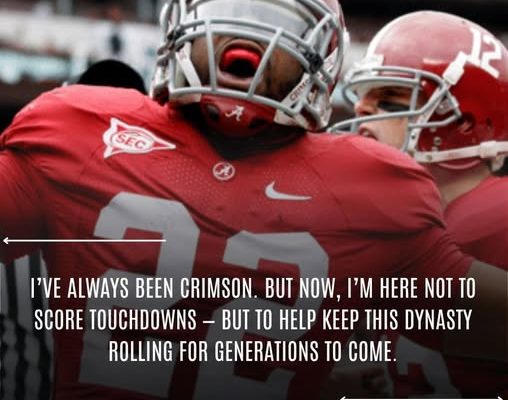Mark Ingram’s return to Tuscaloosa feels like a homecoming story that could only be written in the heart of Alabama football tradition. The former Heisman Trophy winner and national champion, whose name remains etched in Crimson Tide lore, is back in the place where his college legend was forged. This time, though, it’s not to break tackles or score touchdowns, but to serve as a mentor, motivator, and living reminder of what it takes to reach the pinnacle of the sport. Ingram’s journey back to Alabama is more than ceremonial; it’s a bridge between eras, connecting the championship teams of the past with the ones still chasing glory under Nick Saban’s system. His presence in Tuscaloosa is a testament to the enduring bond between player and program, a connection that only grows stronger with time.
Ingram’s college career was the stuff of dreams. Arriving in Tuscaloosa as a four-star recruit in 2008, he quickly proved himself as more than just another talented running back in Saban’s stable. By his sophomore season in 2009, Ingram had become a household name, rushing for over 1,600 yards, scoring 17 touchdowns, and capturing the Heisman Trophy—the first player in Alabama history to ever do so. That year, he led the Tide to a national championship, cementing his legacy as both a statistical standout and an emotional leader. His powerful running style, combined with a relentless work ethic, made him the heartbeat of a team that was redefining Alabama football in the modern era.
After his college days, Ingram’s NFL career spanned over a decade, including a Pro Bowl selection and multiple seasons as a leading rusher with the New Orleans Saints. His professional accomplishments further validated the Alabama pipeline to the NFL, showing recruits that Tuscaloosa isn’t just a place to win college titles, but a launchpad for sustained success at the highest level. Through it all, he remained deeply connected to his alma mater, never hesitating to speak proudly about his time under Saban and the lessons he learned on and off the field. That’s why his return now feels so natural—because in many ways, Ingram never really left.
What makes his return so significant is the role he is set to play. Ingram is not stepping into a coaching position in the traditional sense, nor is he just another former player giving motivational speeches. Instead, he’s stepping into an all-encompassing mentorship role that will allow him to work directly with players, sharing his experience, offering advice, and providing perspective on both the mental and physical demands of championship football. In an era where NIL deals, transfer portals, and heightened media scrutiny can complicate a college athlete’s journey, having a voice like Ingram’s in the building is invaluable. He understands the pressures of being a star player at Alabama, the expectations from fans and media, and the importance of keeping focus amidst distractions.
The timing couldn’t be better for Alabama, either. The Crimson Tide remain perennial contenders, but the competition in the SEC has never been fiercer. Georgia has established itself as a modern powerhouse, LSU is on the rise, and programs like Texas and Oklahoma are joining the conference with high expectations. Every edge matters, and having someone like Ingram embedded within the program offers more than just nostalgia—it’s a competitive advantage. He can walk into a running backs meeting and speak from experience about reading defenses, staying disciplined with footwork, or protecting the quarterback. He can talk to young players about managing their time, staying humble in the face of success, and dealing with adversity.
Ingram’s return also resonates deeply with the fan base. Alabama football is built on tradition, and seeing one of its most beloved figures back in Tuscaloosa stirs pride among supporters. For the students who never got to watch him play live, his presence is a living link to one of the most important chapters in Crimson Tide history. For those who remember his Heisman run, it’s a reminder of what is possible when talent meets dedication. And for recruits visiting campus, it’s a powerful statement: Alabama is a place where legends are made—and where they come back to give back.
His leadership qualities have always been as important as his athletic abilities. In the NFL, Ingram was known as a locker room leader who uplifted teammates and set an example with his preparation. That same charisma and energy are now infused into Alabama’s practices and meeting rooms. Players gravitate toward someone who’s walked the same path and come out on the other side with success and respect intact. Even Coach Saban, a figure renowned for his discipline and high standards, has spoken highly of Ingram’s understanding of the game and ability to connect with players on a personal level. This alignment between head coach and mentor creates a strong support system for the current roster.
There’s also an emotional element to Ingram’s return. He knows what it’s like to put on that crimson jersey and feel the weight of representing not just a team, but a state, a tradition, and a fan base that demands excellence. That emotional connection fuels his desire to contribute beyond the stat sheet. He’s here to help Alabama not only win games but to instill a championship mindset in every player who passes through the program. It’s about cultivating resilience, accountability, and unity—qualities that have defined the Crimson Tide at their best.
In many ways, Ingram’s return reflects the cyclical nature of college football. Players come in as young, unproven prospects, develop into stars, and then move on to the next level. But the truly special ones never really leave; they return to pour back into the program that shaped them. Ingram’s journey is an example for the younger generation that your relationship with your school doesn’t end when you leave for the NFL. It’s a lifelong bond, one that can shape your identity as much as any professional accolade.
Looking ahead, it’s easy to imagine Ingram becoming an even more integral figure in Alabama football’s future. Whether it’s helping develop the next Heisman contender, guiding a team through a playoff run, or simply being a steady voice in the locker room after a tough loss, his impact will be felt in ways that may not always make the headlines but will certainly show up in the results. Championships are built not just on talent and schemes, but on culture—and Ingram embodies the culture that Saban has worked so hard to maintain.
As Alabama eyes its next national championship, the return of Mark Ingram adds another layer of strength to the foundation. He brings credibility, experience, and a deep love for the program. His story is no longer just about the touchdowns he scored or the records he set; it’s about the legacy he’s building in a different way—by helping others succeed. The helmet may be gone, but the fire remains, and that Crimson heart beats as strong as ever. For the Tide, that’s more than just a feel-good story; it’s a reminder that championship culture is sustained by the people who believe in it most.
If Ingram’s first stint in Tuscaloosa was about proving himself as a player, this chapter is about proving that the qualities that made him great on the field—discipline, passion, resilience—can be just as powerful off it. In a program where the margins between winning and losing are razor-thin, having someone of his caliber and commitment around could be the difference-maker. He’s not chasing personal glory anymore; he’s chasing a legacy that will extend far beyond his playing days. That’s what makes his return so meaningful—not just for Alabama, but for college football as a whole.
When you think about the greats in Alabama history, the list is long and distinguished. But what sets Ingram apart is his willingness to turn his success into service for the next generation. That’s the mark of a true champion, and it’s why his return to Tuscaloosa is more than just a reunion—it’s the continuation of a winning tradition. As the Crimson Tide prepare for another run at the top, they’ll do so with one of their own back in the fold, ready to help carry them there once again, not with the ball in his hands, but with wisdom in his voice and pride in his heart.



